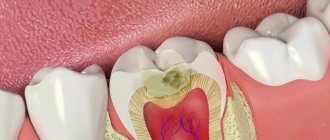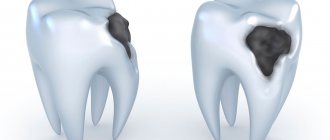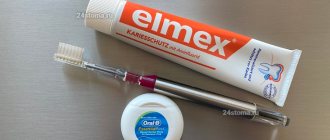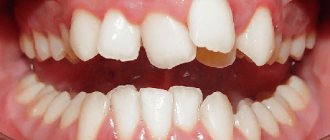If we proceed from the generally accepted canons of the formation of the dental row in a child, then by six months, maximum by 8 months, teeth should appear. However, in reality this does not always happen. Despite reaching the age of eight months, the baby does not experience teething.
Parents should not panic in such a situation, although the question of why the child has no teeth requires an immediate answer. Sometimes such a development of events is only a slight deviation from the norm, but often indicates a serious pathology.
Facts about teething
Teething is a complex physiological process that lasts for several years. During this period, the formation of tooth germs and their movement inside the jaw occurs. The process of teething is most often quite painful. There is a gradual change in the bite: a temporary (milk bite) changes to a permanent one. This is due to the development of bones in the child, in particular, with the growth of the skull bones. Also during this period, the formation of bone structures, soft tissues that surround the tooth, and the resorption of the roots of the milk units occurs to free up space for the permanent ones.
The first stage of tooth formation begins in the embryonic period. The complete completion of this process occurs with the eruption of wisdom teeth at approximately 25 years of age.
How to save your front baby teeth
The main and main cause of damage to the upper anterior incisors in children at an early age is “bottle caries”. And today it is far from uncommon. Moreover, caries begins at a very early age (sometimes even in infancy) and develops not just quickly, but rapidly. Where does it come from? It's simple: caries develops as a result of night feeding with breast milk, artificial formula, compote or juice. Any sugar-containing liquids literally stick to the teeth, flowing from the side on which the baby sleeps and to the front upper teeth. And since saliva is not produced during sleep, sugar remains on the teeth and begins to destroy the enamel, which leads to caries. To the greatest extent (90% of cases) it affects the upper incisors and chewing teeth. And if the treatment of the latter does not cause any particular difficulties, then there are still many questions, disputes and disagreements regarding the front incisors.
Where does caries begin?
Caries begins with a white spot on the tooth, which most often goes unnoticed if the baby is not shown to the pediatric dentist in time. The “white spots” do not bother the baby himself. However, literally within a few months, carious cavities can become very deep, causing the child quite severe discomfort during meals and even at night.
What happens if you don’t treat your child’s teeth?
It’s simple, a fairly extensive chronic inflammatory process will arise, the frequent companions of which, in addition to dental problems themselves, are loose tonsils and other ENT diseases and even diseases of the gastrointestinal tract. In addition, bone tissue and the rudiments of permanent teeth suffer from chronic infection. And when the process reaches a “critical point,” the matter can end in fluxes and purulent fistulas, which are often accompanied by acute pain and high fever.
"Important" age
Children aged 1.5 to 4 years usually turn to pediatric dentists with similar problems. And often children come with almost destroyed front teeth. Namely, during this period, the front incisors are more important than ever, both from an aesthetic and functional point of view: they bear a fairly high load associated with biting food, especially hard food. In addition, without the front teeth, the bite (subsequently there may not be enough space in the jaw for permanent teeth) and speech (the tongue does not have support, and the child begins to lisp) are formed incorrectly. And of course, like adults, kids worry about the beauty of their smile. If black, dilapidated “stumps” stick out in the mouth instead of beautiful white teeth, children are embarrassed to smile and constantly cover their mouths with their hands.
And by the age of 5, the resorption of the roots of milk teeth will begin, and by 6-7 years, permanent teeth should erupt, the health of which directly depends on the condition of their milk predecessors. That is why you need to take care of the health of your upper incisors as early as possible.
What's the difficulty?
There are several reasons why treating frontal teeth in children is very difficult.
Firstly, only when treating incisors with deep damage to the enamel is the passage of canals mandatory. That is, everything is the same as in adults: you need to drill out the tooth, remove the nerve, take before and after pictures, go through the canal with a special material, and only after that can you put a filling. Therefore, treatment of only one front incisor takes 30-40 minutes!
Secondly, as we said, the main patients with caries of the front teeth are children from 1.5 to 3-4 years old (in 80% of cases these are children aged 2-3 years), so treatment is possible only under general anesthesia. For such a baby, finding contact “with someone else’s aunt” is still, to put it mildly, difficult, and the perseverance is still not enough to withstand such a long time in the dentist’s chair (if only the doctor needs an average of 30-40 minutes for one tooth, and such teeth 4 – so count for yourself).
By the way! It does not happen that one or two teeth are affected by caries, and the rest remain healthy - usually all 4 front incisors are always affected.
Background
It is because of all these difficulties that until recently there were not so many ways to “treat” the upper anterior incisors.
Depending on the degree of damage, the teeth were covered with silver. But since this approach gives absolutely no effect, the carious process soon destroyed them completely, and then the teeth had to be removed. The “side effects” of this method also include the fact that the “silver” makes the teeth turn black and, to put it mildly, does not look aesthetically pleasing, which only adds to the problems.
If the situation allowed, then sometimes it was possible to fill the canals in order to save space in the upper jaw for permanent teeth, and in the place of the former “milk jugs” there remained small “stumps” that were in no way capable of fulfilling their functional tasks, not to mention their appearance.
Another “popular” approach is to leave everything as is for as long as possible. We have already talked about fluxes and temperature. Actually, they became the consequences of such “treatment”. Result? Parents are simply forced to bring their child to the clinic for removal.
By the way! In the absence of teeth, the jaw narrows, and this subsequently negatively affects the bite: there is not enough space for permanent teeth!
True, sometimes with the help of all kinds of rinses and “traditional methods of treatment” at home, this acute process is removed, the baby rinses out the pus and continues to live with bad teeth and a chronic infection in the mouth, from which the bone tissue suffers.
By the way! Until 3 years of age, mineralization of the rudiments of the anterior permanent teeth occurs. And in fact, they are formed under conditions of constant inflammation and chronic infection. This means that the rudiments of permanent teeth do not develop normally: the teeth will be weak, and the enamel will be of uneven color and in some places immature.
What to do if teeth are removed after all
One of the modern solutions to this problem is a replacement plastic plate. However, although it holds the jaw well for permanent teeth, it is otherwise purely aesthetic in nature (outwardly it looks like real teeth), without bearing any chewing load.
The plate can only be installed at the age of 4.5-5 years. The fact is that it requires a conscious attitude on the part of the child. You need to take care of the plate, clean it, remember to take it off and put it on, you need to get used to it, like any other foreign object in the mouth. That is, the baby must understand why he is doing it, and, what is important, want to do it! And it is not always possible to “agree” with a child; it is especially problematic to do this with boys.
In addition, if teeth were removed at 2 years old, then at least until the age of 4 years the baby is forced to live without teeth, which is not physiological. Restoration of anterior teeth as an art of pediatric dentistry
Over the past few years, a number of clinics have begun to restore the anterior incisors. The roots of these teeth are treated, pins are placed, and the crown of the teeth is restored using filling materials. For aesthetic restoration, materials of different colors with corresponding names are used - “dentin”, “enamel”, “incisal edge”, so that the teeth can look as close as possible to their real teeth. Crowns: a modern and effective solution
Fortunately, today there is a solution to the problem of the upper incisors, such as crowns. Crowns are made of a hypoallergenic alloy and lined with zirconium oxide. This is a rigid and durable structure, which, like in adults, is attached to cement and holds the tooth well. In addition, from an aesthetic point of view, crowns look good. And children truly appreciate this: they begin to smile with pleasure without covering their mouth with their hand.
So, how does a crown “work” and help save teeth? The root of a tooth affected by caries is treated, the nerve is removed, and a canal is traversed. If the tooth tissue is preserved, then it is minimally filled; if not, then a pin is installed, and the tooth itself is restored (restored) with filling material. On top, slightly under the gum, crowns are placed, which play the role of protective “caps,” mechanically holding the tooth and helping to preserve the restoration until the teeth are replaced with permanent ones. It is by installing it under the gum that the crown helps protect the restored tooth, which consists of 90% filling material, when bitten off or injured.
Since by the time of treatment there is nothing left of your own tooth, crowns are selected “by eye”: impressions, like for adults, are never made. Based on the size of the roots and adjacent teeth, as well as the structure of the jaw, we can determine what size crowns are needed. However, we always install crowns that are slightly smaller than our real teeth to avoid the teeth not coming together when the child wakes up from anesthesia. Over the next few months, the installed crowns “sit” in the bite due to the plastic childhood periodontium and a number of other physiological features. If, for example, when fixing the crown, the crown was turned out, then when the baby comes for a consultation after 2-3 months, the teeth are in a row. Nature literally helps children. This simply cannot happen to an adult!
By the time the baby teeth are replaced by permanent ones, the roots of the “milk jugs” begin to dissolve. As a result, the crowns fall out along with the pin, and permanent teeth take their place.
Clear benefits
Of course, both of these methods allow you to preserve the front incisors until they are physiologically replaced. It is very important! But let's figure out how the baby feels...
Firstly, after treatment of the roots of the teeth and subsequent restoration, the child begins to eat normally and gains weight: after all, with severely damaged teeth, as we said, contact with food causes discomfort and sometimes even acute pain. Meat, apples, carrots appear in the toddler’s diet - that is, things that he simply could not bite or chew before. Secondly, since nothing bothers the baby (and at the stages of deep caries, children often experience pain at night), he sleeps better. Thirdly, the teeth look very aesthetically pleasing, and now the baby can smile from ear to ear without embarrassment. Tell me, is this not enough?
It's important to remember that...
...installing crowns takes less time than aesthetic restoration of teeth using filling materials. And this, in turn, allows you to reduce the time of anesthesia. In addition, the filling material gains color over time (stained by food and drinks), cracks appear on it, so it must be polished periodically. And lastly: crowns allow for 70% better preservation of teeth, protecting them from injury and mechanical damage during chewing. But the materials used for restoration are not strong enough and often break.
Nevertheless, the method of preserving the front teeth in each case is selected individually, depending on a number of indications and contraindications, the state of the oral cavity, etc. The main thing is that now it has become possible! We are convinced that if it is possible to save a child’s teeth for 2-3 years, ensuring normal chewing and jaw development, then this is a huge achievement and truly “aerobatics” for pediatric dentists.
When do the first teeth appear?
At the time of birth, the baby's teeth are in a state of formation inside the jaw bones. The bone contains a complete set of primary teeth at different stages of growth. The front incisors are the earliest to form and begin to emerge through the gums at six months of age. With the correct development of the child, dental units continue to erupt in pairs, i.e. one on each side. A full set of twenty primary teeth should appear in the first three years of a child's life.
Recommendations for avoiding delay
- After tooth loss, you should not eat or drink hot drinks for several hours.
- The plug that forms in the hole cannot be removed to avoid infection. It will disappear on its own.
- It is not advisable to eat solid food for the first time after the loss.
- If you experience pain, redness, swelling or other signs of exacerbation, you should immediately contact your dentist. Remember, our specialists are always ready to help and answer your questions by phone.
How to determine the delay in teething
If a child is 1.5 years old and still does not have a single tooth, then this is a serious reason to seek advice from a dental clinic.
The normal period for the appearance of the first teeth in the oral cavity is considered to be from 4 to 16 months, subsequent teeth appear gradually after the first.
Permanent teeth begin to grow by the age of 6-7 years.
A slight discrepancy with the established deadlines is not a reason to sound the alarm; you should worry if the child has a complete absence of teeth.
No teeth at one year of age
Why does a child’s teeth not grow after a year of life?
- Hereditary predisposition.
- Unsuitable climate.
- Poor quality of food and water.
- Diseases and infections.
- Vitamin and calcium deficiency.
To dispel or confirm suspicions, you need to take your baby for examination to a therapist and dentist. To determine the causes of delayed jaw development, blood tests, urine tests, ultrasound examinations of organs, and testing of thyroid function may be necessary. To exclude edentia (lack of teeth) from the diagnostic field, fluoroscopy is performed.
Types of delay in teething
A discrepancy from the average statistical time of more than six months in the eruption of baby teeth is considered a delay.
The delay from the average time in the appearance of permanent teeth should not exceed a year. There are two types of late eruption.
- Late formation of dental follicle. In such a situation, the relationship between the development of the tooth and its appearance in the oral cavity is observed, but both processes proceed more slowly than expected.
- Late eruption. With this development, the tooth is fully formed, its root grows, but the dental unit cannot erupt. Fully formed teeth remain in the bone – impacted. They may be completely under the gum or partially visible from under it.
Before worrying about delayed eruption, it is necessary to diagnose the presence of a tooth germ in the bone. To do this, a panoramic photograph is taken, which makes it possible to distinguish the complete absence of a rudiment from a delay in formation.
conclusions
We all understand how worried mothers of grown-up toddlers are because the child is 9 months old and has no teeth. After all, it is generally accepted that at nine months babies should already have their front teeth erupting. What to do in this case?
The most important thing in this situation is not to compare your baby with the child of a friend or neighbor. All children are different (doctors often talk about this), so the timing of teething for each will be strictly individual. Even if the first tooth appears at one year old, this is considered absolutely normal.
There is no need to panic if your baby celebrates his first birthday in just a couple of months, but he still sparkles with pink gums when he smiles. Pediatric dentists claim that before the baby turns one and a half years old, at least one tooth will erupt.
Most babies are born without baby teeth. True, their rudiments begin to form in the first trimester of the mother’s pregnancy. It also happens that a child is born with one or two front teeth. But even in this situation there is no need to worry.
Reasons for delay in teething
There can be many reasons for delays in teething.
- Hereditary factor. If parents cut teeth later than other children, then this symptom may also be observed in their children.
- Prematurity or low birth weight of the baby.
- Diseases of the expectant mother during pregnancy, injuries during childbirth, as well as illnesses of the child in the first few months after birth.
The factors listed above most influence the timing of eruption, as well as the quality of formation of dental units.
Other reasons include:
- violations in the child’s diet;
- lack of certain vitamins and minerals;
- hypothyroidism;
- rickets and its consequences.
It should also be taken into account that girls are ahead of boys in development, and, therefore, their teeth appear earlier.
What to do to ensure that your child’s teeth develop normally
Before and during pregnancy:
- Maintain dental health.
- Eat well and varied.
- Eat more foods high in calcium.
- Do not smoke or drink alcohol.
- Walk in the fresh air more often to maintain a healthy level of hemoglobin in the blood.
- Treat in strict accordance with medical recommendations.
After childbirth:
- provide the child with a rich and balanced diet;
- monitor the baby’s hygiene;
- walk in the fresh air to harden the child’s body;
- prevent infection and diseases of internal organs;
- Consult a doctor in a timely manner in case of painful syndromes.
What determines the timing?
The timing of the formation of both temporary and permanent dental units in children can be compared with certain phenomena.
- Floor. In girls, all teeth, except the first upper chewing one, erupt earlier than in boys.
- Jaws. Teeth appear faster on the lower jaw than on the upper jaw.
- Position of teeth. Molars and premolars most often erupt with a delay.
- Bite. In primary dentition, delay occurs much less frequently than in permanent dentition.
- Population. Scientists have found that people living in different countries have different timing for the appearance of teeth. For example, among Europeans, delayed eruption is a fairly common occurrence.
- Climatic conditions. In warm climates, teeth erupt faster than in cold climates.
- Level of urbanization. City residents develop teeth faster than those in rural areas.
- Evolution. Recent generations are more likely to encounter anomalies in the eruption of wisdom teeth and canines in the upper jaw. Scientists explain this phenomenon with the evolution of humans as a species, and with the lack of space due to a decrease in the overall size of the jaw.
What about the deadlines?
Some parents use a special formula to determine how many teeth a baby should have at nine months. It looks like this:
K=M – 4,
where K will be equal to the number of teeth, and M will be the number of months of the toddler’s life.
But even if teething begins only at one year, parents should not panic. This is also the norm.
Children's teeth may appear one at a time or in pairs. Moreover, in this way not only the first ones erupt, but also those following them. There are cases when a baby has as many as four teeth coming out at the same time. By the way, massive teething will affect the timing.
It is human nature to doubt. Especially for parents of little ones. It often happens that a child is 9 months old and has no teeth. Why? If at this age or even a year the baby does not have a single tooth, you should consult a doctor to make sure that the little one does not have rickets or hypothyroidism.
Typically, the first twenty teeth should appear before two and a half to three years of age. Each baby’s jaw should have four incisors, two canines (also called canines) and four molars. In an adult, it is considered normal to have twenty-eight or thirty-two teeth - on each jaw there are 4 incisors, two canines, four premolars and from four to six molars.
When baby teeth begin to emerge, there are initially no gaps between them. This is normal. A little later, when the child’s jaw grows, by the age of four the teeth begin to diverge and gaps form between them. This process is necessary to accommodate the molars because they are much larger than baby teeth. If such gaps do not appear, then subsequently the molars will not be able to fit in and will grow crookedly.
Treatment of adentia in adults
Adult patients are offered various types of removable and fixed dentures. Prosthetics on implants, installation of bridges on four implants and other prosthetic options at the patient’s choice are possible. Depending on the condition of his dental system, financial capabilities and wishes, dentists, as a rule, offer several treatment options to choose from.
When choosing a treatment method, it is important to understand the features of each design. The doctor, based on the condition of the patient’s oral cavity, offers him a choice of several prosthetic options.
Removable dentures
Partial or complete dentures should be replaced every 1.5 to 2 years. Therefore, even with complete loss of teeth, dentists offer an alternative type of prosthetics based on implants.
Clasp dentures
Dentures on a metal frame, on which an acrylic base is installed, and artificial teeth are installed on it. This solution makes it possible to significantly lighten the design of the prosthesis, making it thinner and more comfortable.
Bridges
In case of partial edentia, it is possible to install bridges. The non-removable structure is fixed on adjacent non-grindable teeth.
Implant-supported prosthetics
Implant-supported prosthetics are considered the most reliable and aesthetic way to restore dentition. The main advantages of this type of bone implantation include:
- long service life of the structure;
- aesthetic appearance;
- no need to grind adjacent teeth.
A denture installed on implants completely replaces missing teeth and performs a functional and aesthetic task.
Feeding rules
Frequent regurgitation can be prevented by following a few feeding rules.
- After feeding, it is necessary to hold the baby upright. Even if your baby is tired or wants to sleep, you shouldn’t put him to bed right away. It is very comfortable to hold infants on your shoulder. After waiting for the air to burp, the child can be given any position.
- The same should be done before feeding. The thing is that in an upright position the child can release excess air from the stomach. If this is not done before eating, belching is guaranteed.
- There is a certain position recommended for breastfeeding. One of the main goals of correct positioning of a nursing mother and baby is to prevent regurgitation. The semi-vertical position of the baby with the head raised above the level of the body must be maintained during each feeding.
- Feedings should be frequent, but in small portions. Overfeeding is fraught not only with regurgitation, but also with other digestive problems.
- It is important not to feed your baby when he is crying or laughing, otherwise he will swallow excess air.
- If feeding is carried out using a bottle with a nipple, it is necessary to ensure that the hole in the nipple is not too large, and the position of the bottle is such that the nipple is always filled with mixture and not with air.
- You should refrain from active games in the first half hour after feeding.
Following these simple rules will help reduce the frequency of regurgitation.











